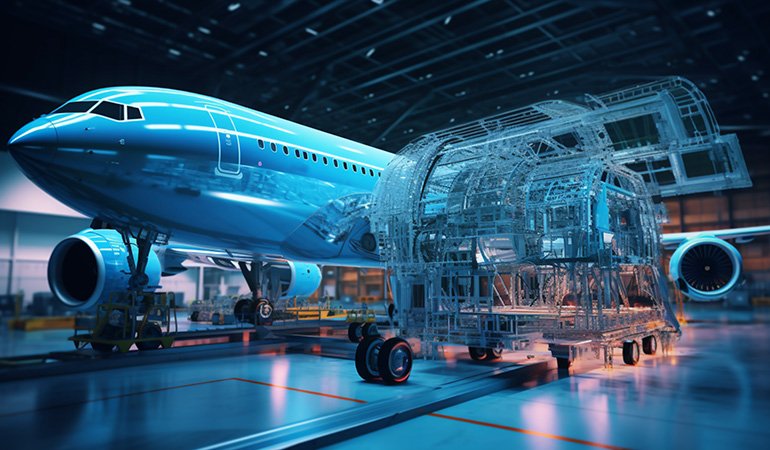Digital twins play a transformative role in enhancing civil aviation maintenance and design by creating virtual replicas of aircraft, systems, or components. These digital models integrate real-time data and advanced simulations to improve performance, efficiency, and reliability.
Role of Digital Twins in Civil Aviation
1. Predictive Maintenance
- Function: Digital twins use real-time sensor data from aircraft to monitor the health of components and systems.
- Benefits:
- Detect potential issues before they lead to failures.
- Minimize unplanned downtime by scheduling maintenance proactively.
- Extend the lifespan of components through optimized maintenance cycles.
- Example: Monitoring engine performance to predict wear and recommend part replacements.
2. Enhanced Aircraft Design
- Function: Simulations within digital twins allow engineers to test designs under various conditions.
- Benefits:
- Identify structural or aerodynamic inefficiencies early in the development process.
- Reduce prototyping costs and development time.
- Optimize materials and component configurations for weight reduction and fuel efficiency.
- Example: Airbus and Boeing use digital twins to test and refine aerodynamics and cabin layouts.
3. Real-Time Performance Monitoring
- Function: Digital twins provide a continuous stream of operational data from in-service aircraft.
- Benefits:
- Enable operators to track fuel efficiency, engine output, and environmental conditions.
- Adjust flight operations for optimal performance.
- Example: Monitoring an aircraft’s fuel usage to recommend route or speed adjustments.
4. Streamlined Maintenance Operations
- Function: Digital twins integrate historical maintenance records, operational data, and simulations.
- Benefits:
- Accelerate troubleshooting by identifying root causes of failures.
- Provide technicians with actionable insights and repair recommendations.
- Ensure compliance with regulatory standards through accurate documentation.
- Example: Using a digital twin to simulate a hydraulic system failure and determine the most effective repair strategy.
5. Improved Passenger Experience
- Function: Digital twins model cabin conditions, such as airflow, lighting, and seating configurations.
- Benefits:
- Enhance passenger comfort and safety by optimizing environmental controls.
- Enable airlines to simulate and test cabin designs for better utilization of space.
- Example: Testing airflow patterns to minimize the spread of airborne particles in the cabin.
6. Training and Simulation
- Function: Digital twins replicate real-world scenarios for pilot and technician training.
- Benefits:
- Provide realistic simulations for learning without physical aircraft or components.
- Enhance understanding of complex systems and failure scenarios.
- Example: Simulating engine failure scenarios for pilot training.
7. Sustainability and Emission Reduction
- Function: Digital twins analyze and optimize fuel consumption, emissions, and flight paths.
- Benefits:
- Help airlines meet environmental goals and regulatory requirements.
- Reduce carbon footprint through more efficient operations.
- Example: Testing sustainable aviation fuel (SAF) effects on engine performance.
Technological Components of Digital Twins
- IoT Sensors:
- Collect real-time data from aircraft systems and components.
- Artificial Intelligence (AI):
- Analyzes data to predict outcomes and optimize performance.
- Cloud Computing:
- Enables seamless data storage and accessibility for global operations.
- Simulation Software:
- Models complex scenarios for testing and analysis.
Advantages of Digital Twins in Civil Aviation
- Cost Efficiency:
- Reduces prototyping and operational costs.
- Improved Safety:
- Enhances fault detection and operational insights.
- Faster Decision-Making:
- Real-time data enables quicker responses to issues.
- Regulatory Compliance:
- Ensures adherence to maintenance and safety standards.
Challenges
- Data Integration:
- Requires seamless integration of diverse data sources.
- High Initial Investment:
- Significant resources are needed to develop and deploy digital twin technology.
- Cybersecurity Risks:
- Protecting sensitive operational data is critical.
Conclusion
Digital twins are revolutionizing civil aviation by enhancing maintenance efficiency, improving aircraft design, and optimizing operations. As technology advances, their role will become increasingly central to achieving greater safety, sustainability, and cost-effectiveness in the aviation industry.
Hashtags
#DigitalTwins #AviationDigitalTwins #SmartAviationTech #NextGenAviationTools #DigitalInnovationInAviation #DigitalTwinsForMaintenance #PredictiveMaintenanceTech #AviationMROInnovation #SmartAircraftMaintenance #DigitalTwinsInDesign #EfficientAviationDesign #ReliableAircraftSystems #RealTimeAviationData #SustainableAircraftDesign #FutureOfAviationTech #CollaborativeAviationDesign













